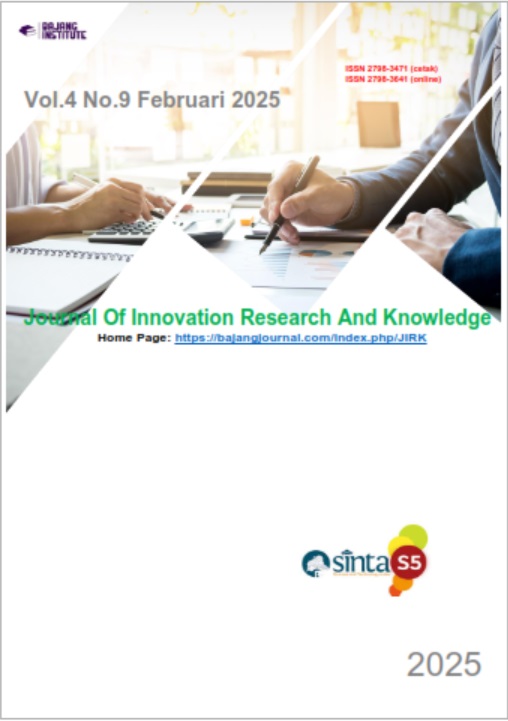ANALYSIS OF CYANIDE ACID (HCN), CRUDE PROTEIN AND GROSS ENERGY CONTENT IN WINPROB (OTW_PRO) POWDER FERMENTED WASTE AT DIFFERENT TIMES
DOI:
https://doi.org/10.53625/jirk.v4i9.9717Keywords:
Onggok, Fermentasi, Cyanide Acid (HCN), Crude Protein And Gross EnergyAbstract
The aim of this research is to determine the best storage time for the fermentation process for the content of cyanide acid (HCN), crude protein and gross energy in fermented winprob (otw_pro) onggok in powder form. The hypothesis of this research is that the best storage time for the fermentation process can reduce and increase the content of cyanide acid (HCN) and increase crude protein and gross energy in fermented winprob (otw_pro) onggok in powder form. The materials used in the research were onggok, winprob (powder form) and molasses. Materials for chemical feed nutritional tests are H2SO4, NaOH, Acetone, Boric acid HCl and methyl red indicator. The tools used are plastic jars, buckets, knives, and scales. The tools used in nutritional chemistry tests are calorie meter bombs, thermometers, digestion tools, distillation tools, titration tools, and shoxlet tools. The research method used in the research was a non-factorial Completely Randomized Design (CRD) with 5 treatments and 4 replications. The treatments given were as follows: LP0: storage time 0 days (control), LP 1: storage time 1 week, LP2: storage time 2 weeks, LP3: storage time 3 weeks, and LP4: storage time 4 weeks. The parameters observed in this research were analysis of the content of cyanide acid (HCN), crude protein and gross energy in Winprob (otw_pro) fermented onggok in powder form. Proximate testing is carried out in the laboratory. The conclusion of this research is that onggok fermented with Win Prob probiotics in powder form with a storage period of 3 weeks is the best treatment which can reduce cyanide acid (HCN) content and increase crude protein and gross energy.
References
Adamafio, N. A., Sakyiamah, M., & Tettey, J. (2010). Fermentation in cassava (Manihot esculenta Crantz) pulp juice improves nutritive value of cassava peel. African Journal of Biochemistry Research, 4(3), 51–56.
Asngad, A. (2005). Perubahan Kadar Protein pada Fermentasi Jerami Padi dengan Penambahan Onggok untuk Makanan Ternak.
Ezraneti, R., Erlangga, E., & Marzuki, E. (2018). Fortifikasi probiotik dalam pakan untuk meningkatkan pertumbuhan ikan gurami (Osphronemus gouramy). Acta Aquatica: Aquatic Sciences Journal, 5(2), 64–68.
Fuad, M., Subaryono, S., Samsudin, R., & Widyastuti, Y. R. (2018a). PENINGKATAN KUALITAS NUTRIEN ONGGOK YANG DIFERMENTASIMENGGUNAKAN Bacillus megaterium SS4b SEBAGAI BAHAN BAKU PAKAN IKAN. Jurnal Riset Akuakultur, 13(2), 147–157.
Fuad, M., Subaryono, S., Samsudin, R., & Widyastuti, Y. R. (2018b). PENINGKATAN KUALITAS NUTRIEN ONGGOK YANG DIFERMENTASIMENGGUNAKAN Bacillus megaterium SS4b SEBAGAI BAHAN BAKU PAKAN IKAN. Jurnal Riset Akuakultur, 13(2), 147–157.
Hidayat, B., Muslihudin, M., & Akmal, S. (2018). Perubahan Karakteristik Fisikokimia Tepung Onggok Selama Proses Fermentasi Semi Padat Menggunakan Saccharomyces cerevisiae. Jurnal Penelitian Pertanian Terapan, 18(3), 146–152.
Kompiang, I. P. (2009). Pemanfaatan mikroorganisme sebagai probiotik untuk meningkatkan produksi ternak unggas di Indonesia. Pengembangan Inovasi Pertanian, 2(3), 177–191.
Lasminingrat, L., & Efriza, E. (2020). Pembangunan lumbung pangan nasional: Strategi antisipasi krisis pangan indonesia. Jurnal Pertahanan Dan Bela Negara, 10(3), 243–260.
Oboh, G. (2006). Nutrient enrichment of cassava peels using a mixed culture of Saccharomyces cerevisae and Lactobacillus spp solid media fermentation techniques. Electronic Journal of Biotechnology, 9(1), 0.
Pratama, V. A., & Siregar, D. J. S. (2024). EVALUATION OF STORAGE LENGTH ON THE NUTRIENT QUALITY OF WIN PROB FERMENTED WOODS (OTW_PRO) IN LIQUID FORM. Journal of Innovation Research and Knowledge, 3(12), 2311–2320.
Sari, Fi. D. N., & Astili, R. (2018). Kandungan asam sianida dendeng dari limbah kulit singkong. Jurnal Dunia Gizi, 1(1), 20.
Sjofjan, O., & Djunaidi, I. H. (2016). Pengaruh beberapa jenis pakan komersial terhadap kinerja produksi kuantitatif dan kualitatif ayam pedaging. Buletin Peternakan, 40(3), 187.
Stephanie Dan Purwadaria, T. (2013). Fermentasi substrat padat kulit singkong sebagai bahan pakan ternak unggas. Wartazoa, 23(1), 15–22.
Suharno, B. (2020). Prospek Peternakan Di Era Normal Baru Pasca Pandemi Covid-19 (Sudut Pandang Media). PROSIDING SEMINAR NASIONAL TEKNOLOGI AGRIBISNIS PETERNAKAN (STAP), 7, 36–40.
Utama, C. S., & Christiyanto, M. (2021). Potensi Litter Ayam Broiler Sebagai Pakan Alternatif.
Utomo, R., Budhi, S. P. S., & Astuti, I. F. (2013). Pengaruh level onggok sebagai aditif terhadap kualitas silase isi rumen sapi the effect of cassava pomace level as additive on quality of rumen content silage. Buletin Peternakan Vol, 37(3), 173–180.
Yani, A. V., & Akbar, M. (2019). Pembuatan tepung mocaf (modified cassava flour) dengan berbagai varietas ubi kayu dan lama fermentasi. Edible: Jurnal Penelitian Ilmu-Ilmu Teknologi Pangan, 7(1), 40–48.
Yuningsih, Y. (2012). Keracunan Sianida pada Hewan dan Upaya Pencegahannya. Jurnal Penelitian Dan Pengembangan Pertanian, 31(1), 30897.













